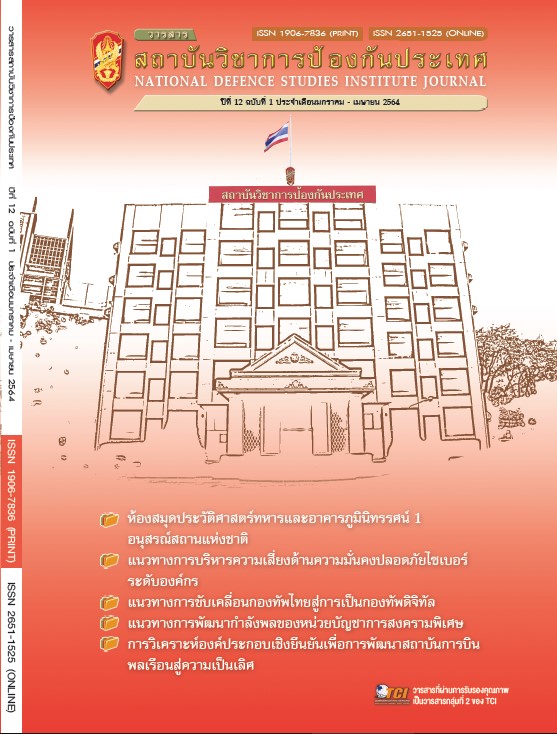A Study of Conditions of Information Technology Usage in Learning Management of Air Technical Training School Teachers
Main Article Content
Abstract
This research aims to 1) study the conditions of using information technology in learning management of Air Technical Training School teachers and the opinions of students in the Air Technical Training School; and 2) compare the opinions of students and teachers’ practices in using information technology in learning management. The sample consists of 40 teachers classified by rank and 265 students in the Air Technical Training School by stratified random sampling. The tools consist of: 1) questionnaire for teachers; and 2) questionnaire for students. All tools validate content validity in between 0.60-1.00 and reliability is 0.97 and 0.93. The researchers collected data by themselves. Data are analyzed by finding frequency, percentage, mean, standard deviation and the average scores are compared with t-test independent.
The results show that: 1) the teachers at the rank of commissioned and non-commissioned officers use information technology in learning management consistently at a moderate level, and the first-year and second-year students have consistently moderate level opinion towards the use of information technology in teachers’ learning management; and 2) teachers at the rank of commissioned and non-commissioned officers use information technology in learning management differently. Differences are not statistically significant at the level of .05. For the first-year and second-year students, there is no statistically significant difference at the level of .05 regarding information technology usage in learning management of teachers. Moreover, the teachers and the students have different opinions regarding overall and each aspect of the use of information technology in learning management. There is statistical insignificance at the level of .05 except for measurement and evaluation differences with statistical significance at the level of .05.
Article Details

This work is licensed under a Creative Commons Attribution-NonCommercial-NoDerivatives 4.0 International License.
The articles, images, tables, graphs, written content, and opinions published in this journal are solely those of the authors and do not necessarily reflect the views or positions of the National Defence Studies Institute or its academic affiliates.
References
กรมยุทธศึกษาทหารอากาศ, โรงเรียนจ่าอากาศ. (2557). หลักสูตรโรงเรียนจ่าอากาศ พุทธศักราช 2557. กรุงเทพฯ:กองทัพอากาศ.
______. (2561). รายงานการประเมินตนเองของสถานศึกษากลาโหม ประจำปีการศึกษา 2561. สืบค้นเมื่อ 29 มีนาคม 2563, จาก http://www.atts.rtaf.mi.th/images/QA_atts/_61.pdf
กองทัพอากาศ. (2563). นโยบายผู้บัญชาการทหารอากาศ ประจำปีพุทธศักราช 2563. สืบค้นเมื่อ 29 มีนาคม 2563,จาก http://ratfaqa.org/images/colum_1485851725/19484_Policy%20Rtaf%202563%20Final-1.pdf
ณิรดา เวชญาลักษณ์. (2559). การบริหารจัดการชั้นเรียนเพื่อส่งเสริมการเรียนรู้ ในศตวรรษที่ 21. วารสารบัณฑิตศึกษา มหาวิทยาลัยราชภัฏสกลนคร, 13(61), 11-20.
ติณณา อภิวัณทนาพร. (2561). การจัดการเรียนรู้ที่ส่งเสริมการใช้เทคโนโลยีสารสนเทศของนักเรียนระดับชั้นมัธยมศึกษาตอนปลาย โรงเรียนสังกัดกรุงเทพมหานคร (วิทยานิพนธ์ปริญญามหาบัณฑิต). มหาวิทยาลัยรังสิต. ปทุมธานี .
นิทัศน์ กลัดแก้ว. (2559). การนำเทคโนโลยีสารสนเทศและการสื่อสารมาใช้ในสถานศึกษาขั้นพื้นฐาน จังหวัดอ่างทอง (วิทยานิพนธ์ปริญญามหาบัณฑิต). มหาวิทยาลัยราชภัฏวไลยอลงกรณ์ ในพระบรมราชูปถัมภ์. ปทุมธานี.
บุญชม ศรีสะอาด. (2556). การวิจัยเบื้องต้น (พิมพ์ครั้งที่ 9). กรุงเทพฯ: สุวีริยาสาส์น.
พชตวรรณ พัฒทุม. (2555). ความสามารถในการใช้เทคโนโลยีสารสนเทศเพื่อกระบวนการจัดการเรียนรู้ของครูโรงเรียนประถมศึกษา ในสังกัดเทศบาลนครแหลมฉบัง จังหวัดชลบุรี (วิทยานิพนธ์ปริญญามหาบัณฑิต). มหาวิทยาลัยบูรพา. ชลบุรี .
“พระราชบัญญัติการศึกษาแห่งชาติ พ.ศ.2542” (2542, 19 สิงหาคม). ราชกิจจานุเบกษา. เล่ม 116 ตอนที่ 74 ก. หน้า 2. สืบค้นเมื่อ 29 มีนาคม 2562, จาก http://www.ratchakitcha.soc.go.th/DATA/PDF/2542/A/074/1.PDF
Krejcie, R. V. & Morgan, D. W. (1970). Determining Sample Size for Research Activities. Educational and Psychological Measurement, 30(3), 607-610.
Likert, R. (1967). The Method of Constructing and Attitude Scale. In Reading in Fishbeic, M (Ed.),Attitude Theory and Measurement (p.90-95). New York: Wiley & Son.


